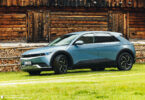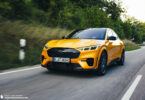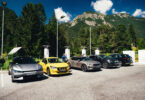Think dolce vita, gelato and Ferrari, and you’ll immediately think Italy – the same goes for the Fiat 500. With the new Fiat 500e 3+1, the Italian brand haven’t just brought a legend back to life but pulled out all the stops to reinterpret it. Read our review to find out how it fares and why the Fiat 500e 3+1 ICON has opera genes!

You can find all electric Cars in our big EV special “Which is the best electric car of 2023?“, where you can also check out our personal EV buyer’s guide – free of charge!
Like pizza, pasta and gelato – the Fiat 500e is just as popular with the Italians and therefore the best-selling electric car in the boot-shaped country. It’s hardly surprising, considering the fact that the adorable runabout has been a part of Italy’s streetscape for almost as long as they’ve had ice cream parlours. The first 500 model was launched as far back as 1957, offering simple technology, space for up to 4 adults at a length of 3 metres. By 1977, nearly 4 million had rolled off the production lines, mobilising a large portion of the Italian population. After a 30-year break, the Fiat 500 was brought up to modern standards and reintroduced in 2007. In 2020, Fiat boarded the electric bandwagon, making the new 500e their first electric car. Apart from the charming looks, it has nothing in common with its petrol-driven counterpart, as it’s based on an entirely new platform, available from € 27,710. But not so fast – how does modern e-mobility fit with the charm of a small car from the 1950s? Fiat had to pull out all the stops to make their all-new EV exude that typical Italian flair of the iconic 500.
Back to the 50’s – The design of the Fiat 500e 3+1 ICON
Even though the Fiat 500e is completely new, it takes us back to 1957, at least in part. The designers of the Fiat 500e 3+1 have succeeded in transporting the iconic car’s charm into the modern age through the clever use of design elements. As before, the shape is characterised by curved lines, although it has become somewhat bigger overall. Priced at € 36,990, the ICON model on test comes in a subtle sky blue, though it’s available in many other nature-inspired colours. The € 2,000 style package enhances the car cosmetically with chrome trims and larger 17″ alloy rims. For another € 2,000, you get the tech package, providing a host of modern safety and comfort features, dispelling any fears that the Fiat 500e is too stuck in the past. Besides the ICON model on test, you’ve got two other versions to choose from, the RED and La Prima by Bocelli. As the name suggests, the fiery Fiat 500e RED features a red exterior as well as red accents on the interior. The flagship La Prima by Bocelli model is characterised by a JBL audio system, specially tuned by the popular opera singer, songwriter and producer Andrea Bocelli.




It’s not just the acoustics in the interior that matter but also the e-sound that’s important for the perception of value. While most electric cars buzz along the streets like spaceships (cool!) or golf carts (ugh!), the Fiat 500e does things differently. It puts on a performance that’s worthy of the big screen, and could even compete with some orchestras, playing an aria-like melody the first time it pulls away. However, as impressive as this aria seems, as sobering – and inconsistent – is the Italian e-runabout’s remaining sound experience. The sound of the motor is very discreet on both the inside and outside, almost like it’s shy. In addition, the start-up jingle of the operating system is equally unworthy of a La Scala opera house appearance, feeling more like an obscure elevator experience.
Elegance meets tech – The interior of the Fiat 500e 3+1
Although most cars keep getting bigger, the Fiat 500e is still relatively small, measuring just 3.6 metres long and 1.7 metres wide while still offering enough space for two adults, at least up front. This is partly thanks to the newly designed centre console, which feels generously spacious and offers plenty of storage. Elegance meets tech in the interior as the flowing lines of the exterior are carried through to the curves of the colour-matched panels on the dash. There’s an inductive charging station for your smartphone, integrated into the centre console. The seats are covered in fabric, which, according to Fiat, is partly made of recycled materials.



If you look for the interior door handle, you’ll search in vain. You can try going with “open sesame”, but it won’t help either. To open the door, you’ve got to push an electric button on the door trim panel. However, should the electrical system fail, the door can be opened via an emergency handle.
You’ll notice many other interesting details if you let your gaze wander around the interior, like the small Fiat 500 relief hidden in the armrest, harkening back to the original model. The Fiat 500 is available in various configurations: a standard 3-door, convertible and – like our test vehicle – a 3+1 model. The +1 stands for the half-door located behind the passenger door, making it easier to access the rear passenger seats. Unfortunately, this isn’t much use to larger passengers, as there is very little space at the rear. Since the rear bench serves more as an emergency seat, the Fiat 500e can’t be considered a true four-seater. That said, even tall folks have plenty of space up front. The steering wheel is shaped to provide additional legroom since it doesn’t collide with your legs when turning. The 185 litre luggage compartment doesn’t offer enough space for your monthly supply of drinks, but you will be able to fit two crates for a comfortable evening with your better half. In a pinch, the rear seats can be folded down, expanding the luggage capacity to 550 litres. Unfortunately, you’ll have to store the charging cable in the trunk since the car doesn’t have the convenience of a storage compartment up front, further reducing the usable luggage capacity.



As hectic as a learner driver – Semi-autonomous driving and other assist functions in the Fiat 500e 3+1 ICON
Iconic or not, Fiat have gone with the times, equipping the new 500e with various electronic assist functions. The € 2,000 Tech Package includes Lane Keep Assist, Adaptive Cruise Control and Sign Recognition. Automotive assist functions have become an indispensable part of modern mobility, but there are still big differences in the way they work. These assistance and safety systems are intended to make driving less stressful and, above all, safer. However, with the Fiat 500e, you get the feeling that you’re being chaperoned by a nervous learner driver (at least with the latest software version installed in our test vehicle). The Lane Keep Assist and Adaptive Cruise Control are very rough and imprecise. Using Lane Keep Assist you’ll find yourself driving very closely to the shoulder of the road, and in complete disregard of lanes, especially on construction sites with several road markings. The Adaptive Cruise Control slams on the brakes harshly when another vehicle pulls in front of you, and you must push the accelerator yourself in slow moving traffic, due to the lack of a stop-and-go function. The Adaptive Cruise Control only intervenes in extreme cases, almost catching you off guard. Compared to the much more expensive KIA EV6 GT-Line, however, it does so reliably, effectively functioning as a kind of digital guardian angel when driving carelessly.

Almost everything gets controlled via the touch display on the centre console. Unfortunately, the display is littered with icons, which can become just as overwhelming as an overly large selection of ice cream flavours at the gelateria. Moreover, the icons are very small, and you must aim precisely to hit the desired function or menu item. Ultimately, if you’re travelling by yourself, operating the touch screen can be distracting and dangerous. But you don’t have to rely solely on the touch screen, because the Fiat offers a good mix of analogue keys and touch functions. For the air-conditioning and ventilation, you’ll find a row of buttons located centrally beneath the display, so you don’t have to go searching the depths of the digital menu just to operate the AC. The volume of the sound system can also be adjusted via a dial or buttons on the steering wheel. It doesn’t matter whether you’re camp Apple or Android, the 500e supports both Apple CarPlay and Android Auto. Compared to the KIA EV6 GT-Line or the Polestar 2, there’s no cable necessary and the automatic connection works perfectly when climbing in and out.
Range, charging and navigation – The capabilities of the Fiat 500e 3+1
According to Fiat, the electrified 500e will achieve up to 320 km (WLTP) with a consumption of 15.6 kWh per 100 km. Once the 42 kWh battery is empty, the manufacturers claim that you should be able to get an additional 50 km with just 5 minutes of charging. The battery can be charged at a maximum power of up to 85 kW. However, this only corresponds to the peak power that the battery can absorb, and it can’t be sustained for very long. To conserve the storage capacity and enable as many charging cycles as possible, the average charging power is much lower. From about 30% state of charge (SoC), the performance is gradually reduced. According to the manufacturer, it takes about 35 minutes to reach 80%, and just under an hour to get up to 100% capacity. If you own a wall charger, you can juice up the Italian stallion at up to 11 kW. In that case, a full charge takes just over 4 hours.




If your destination is out of range based on the current charge status, the navigation system will tell you so. Should that be the case, it will simply indicate nearby charging stations. We would have preferred the software to go one step further, looking for a charging station along the route and thereby exploiting the full potential range. To minimise distraction, the navigation can also be displayed on the speedometer, and not just on the large centre display. The voice command easily recognises destination names in German, though it requires you to confirm commands repeatedly, which doesn’t just get annoying, but also distracting.
Driving the Fiat 500e 3+1 ICON – Where the rubber meets the road
If your destination is out of range based on the current charge status, the navigation system will tell you so. Should that be the case, it will simply indicate nearby charging stations. We would have preferred the software to go one step further, looking for a charging station along the route and thereby exploiting the full potential range. To minimise distraction, the navigation can also be displayed on the speedometer, and not just on the large centre display. The voice command easily recognises destination names in German, though it requires you to confirm commands repeatedly, which doesn’t just get annoying, but also distracting.
The e-Mode switch on the centre console lets you toggle the various driving modes: Normal, Sherpa, Turtle and Range. The Normal mode needs little explanation, but what about Sherpa and Range? Sherpa mode doesn’t mean you’ll suddenly be able to conquer Mount Everest with the Fiat 500e. Rather, it’s designed to maximise range when the battery is running low, limiting the top speed to 80 km/h, and deactivating power-hungry luxuries like seat heating and air conditioning. Turtle mode gets activated automatically when the remaining range is less than 24 km, gradually shutting things down to save battery power. The Range mode takes some getting used to due to the upregulated regenerative braking, which means that each time you lift your foot off the gas pedal, the car essentially behaves as if you pressed the brake and recovers energy, but once you’re acclimatised to it, using the one-pedal driving technique becomes very intuitive.

You might think that this EV will handle like a go-cart considering its compact size. However, that isn’t the case as the soft steering provides far too little feedback. Visibility isn’t one of its strengths either, because the B-pillar and thick C-Pillar restricts the field of view when checking your blind spot or manoeuvring into a parking bay. That said, it’s made for Italian roads! It’s got more body roll than a Smart EQ Forfour, but it scores with a comfortable and soft ride – perfect for dancing through Italian city centres!
Conclusion
Fiat have managed to transport the charm of the original 500 into the modern era, ticking a lot of the right boxes but still leaving some room for improvement, such as the EV’s inconsistent acoustics and its somewhat rudimentary driver assist systems. Nevertheless, you’ll always have a guardian angel on your shoulder in the Fiat. If you’re looking for a sporty, compact car that handles like a go-kart, you’ll be disappointed. Those who love design, style icons, Italian flair and navigating narrow cobblestone alleys, this is the car for you!

Tops
- an icon brought into the modern age
- cool design
- nimble and agile
- sufficient range for suburban areas
- an aria performance worthy of the big screen
Flops
- rudimentary assistance systems
- the charging cable gets stored in the trunk
- inconsistent acoustics
- minimal space in the rear despite the cool half-door
All tested e-cars: City Transformer Prototyp | Fiat 500e | Honda e | KIA EV6 | Opel Rocks E | Polestar 2 | Porsche Taycan | Smart EQ Forfour | Tesla Model 3 Dual Motor Long Range | VW ID.3 | VW ID.BUZZ
Words: Mike Hunger Photos: Peter Walker







